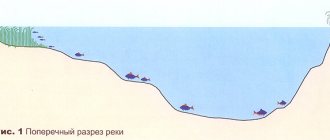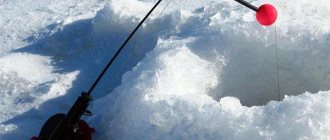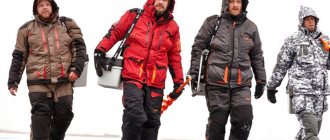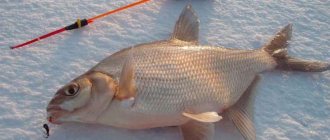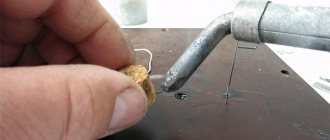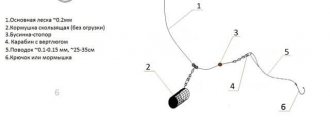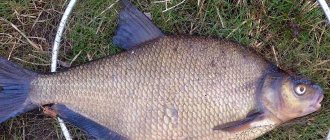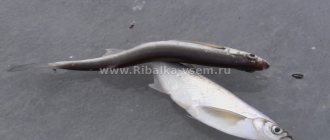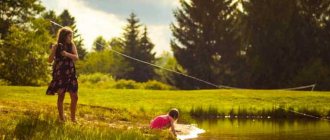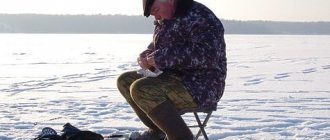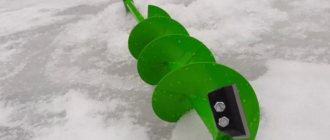Winter bream fishing, especially from thick ice in a freshly drilled hole, has several noticeable features, unlike summer fishing.
The designs and configurations of bream fishing rods, as well as the methods of catching bream in winter fishing from ice and in summer from the shore or boat are completely different.
Although a reservation should be made here: the bream equipment of winter and summer bottom fishing rods intended for catching bream in fish habitats along the river may be similar and even the same.
But taking into account the peculiarities, for example, of catching a school of bream migrating along a narrow bream path from thick ice in a place limited by the small size of the drilled hole. Compare with summer fishing with bottom or float rigs from the side of a boat.
The configurations of my bottom fishing rods are equally suitable for both winter and summer bream fishing on the river. As for the features of winter fishing, most of us drill holes in thick ice with an inclination along the flow of a flowing reservoir.
Drilling holes for promising fishing
For promising winter fishing, you should find the highest concentration of bream in a drilled hole, either in a short-term habitat during the feeding period, or use bait to detain a school of fish migrating along the bream trail. And for these purposes, it is often necessary, despite the thickness of the ice, to drill a considerable number of holes.
Drilling a hole with a narrow drill can be done in several stages. Usually, at the site of promising winter fishing for large bream, double holes are drilled either without a bridge or with an ice bridge, which is then removed. If the ice is thick, then the ice bridge is removed in several stages.
Another feature is that the long-term habitats of bream under ice cover and the location of food pastures - they are also the best winter fishing grounds - during winter fishing can be strikingly different from areas with food developing in the summer.
Between these areas in reservoirs with running water, winter bream prefers to make its way along its so-called bream trails.
Therefore, when looking for a patch of ice for winter bream fishing, you should not confuse three areas with different fishing prospects: feeding areas of active (hungry) bream, areas of long-term residence of bream schools on vacation, and the directions of sometimes rather narrow bream trails along which schools of bream travel from resting places in the feeding areas of the reservoir.
Taking into account the above-mentioned features, perhaps some fishermen will find it useful to have this experience of drilling wide double holes in a place for winter bream fishing with an ice auger only with a narrow auger.
Drilling a hole for catching bream
A method for drilling a double hole at a promising winter fishing site for large bream is shown in the drawing. If you attacked a feeding school of bream in some part of a winter pond or on a bream trail and you have problems with the width of the hole, you can widen the ice glass with a narrow drill.
Moreover, having passed through a double hole drilled with an ice drill in winter ice without any injuries caused by the hook, the bream will thank you again.
To do this, using a titanium or ordinary winter drill with a narrow auger, two parallel holes are drilled with a slight overlap to each other. When fishing for bream in a winter closed reservoir without a current, the direction of both “glasses” in the drilled holes should be vertical.
Injury to large bream during such winter fishing is minimal, but we must see the fish for the hatchery at the entrance to the hole. Therefore, after drilling a double hole, the glass of the cavity in the ice should be clean, and the fishing line on the tackle, accordingly, should be thick (diameter 0.2-0.22 mm).
The example of drilling a double hole shown above is more suitable for winter fishing for bream with float rods on the first ice in a reservoir without a current. True, this method of drilling a hole has one significant drawback.
“Collision” of paired holes into each other
If the ice auger has a bent axis of rotation, then in the process of drilling a paired hole in thick ice, the auger can gradually slide into the already drilled ice glass. Therefore, at the lower end, the diameter of the hole will correspond to the size of the spacing of the outer ends of the knives on the ice drill.
If the paired holes actually “run into” each other, then you can drill through the thick ice in the place where you catch bream and remove the sludge in several stages.
First, drill both holes only to a third of the ice thickness, where you can still adjust the angle of the ice drill using dry ice. Then, with two passes of the ice drill, the second third of the thickness of the ice cover of the water is drilled. And drill the rest of the ice in two or three passes.
Simple holes in ice
Winter fishing is impossible without breaking the ice to get to the water and lower your fishing rods there. This work is partly physically difficult, especially in those periods that occur in the middle and end of winter, when the thickness of the ice reaches several tens of centimeters. Simple holes in ice are made mainly with an ice axe, an ice pick and an ice auger. You can use a simple ax as an ice ax and use it when the ice has just formed and does not offer much resistance. But with ice thickness even up to 10 cm, the ax will no longer help and you have to make holes with an ice drill. The pick is used to cut through, expand the size of the hole or trim its edges.
Before you start developing holes, you must first clear the snow right down to the ice and put it on the leeward side so that it does not backfill the holes. Experienced fishermen drill several holes at once, about 5 to 8 pieces, at a distance of 1.5 to 2.0 m. This is done so that they can make attempts to find a school of perch, roach or other fish. If there is only one hole above it, you can sit all day to no avail. And sometimes you also have to drill holes in the hope of luck. That's what fishing is like!
When using a drill, the holes are of the correct shape and have smooth walls. If you cut holes with an ice pick, you must first cut through the ice along the intended circumference, and then in the middle. Do not forget to attach the handle of the pick to your hand with some kind of cord, because there have been cases when, due to carelessness, the pick went under the ice. To ensure that the holes you drill do not blend into the snow, mark each one with a certain sign - this will save you time searching for them.
The Leningradsky ice drill has been considered a reliable device for drilling holes in ice for many years.
This is very important because winter days are short. And one more thing you need to do: after drilling the holes, immediately feed the fish in it - this will significantly increase the chances of successful fishing.
Do not try to drill holes left by previous fishermen, because the drill knives will get stuck in them and you will lose a lot of time. After work on drilling holes has been temporarily suspended, there is no need to discard the drill and immediately begin fishing. If you do this, the instrument will become covered with ice, which will then need to be removed in various ways. By the way, how to properly remove ice from an ice auger? Firstly, never knock the ice off the knives, secondly, do not try to melt the ice on the fire because there is a fear that the metal on the knives will loosen and lose its hardness, and thirdly, if possible, lubricate the knives with machine oil.
The easiest way to have simple holes in the ice is to use old ones left over from fishermen, unless they are frozen, of course. Especially if you are a pensioner and you have the opportunity to fish on a weekday. This would be unfounded if he himself had not resorted to this method by his own example, while fishing in the Rest House, which was located on the shore of a large reservoir. But, I repeat, the weather was not very cold at the limit of 0 ºС and the holes simply did not freeze. And what do you think? I caught about fifty perch just as the holes were not only drilled, but also baited.
Double hole for bream fishing
Drilling a double hole in a place where you catch bream with a winter fishing rod is associated with some difficulties in two cases.
At the end of winter, when in order to catch bream using a nodding tackle with a jig, you have to drill double holes in a thick mass of ice, during the drilling process the second hole can “drive” into the first (especially if the joint of the auger with the handle of the ice drill is loose or the auger pipe is bent).
This is exactly what I meant above in the text. It is also very problematic to drill a double hole if the quality of sharpening of the ice drill knives is different.
It is impossible to fix a double hole, just as it is quite problematic to drag a large bream through a hole narrowly drilled in thick ice even with the help of a hook.
And, nevertheless, to catch bream in winter on the river flow, even from not very thick ice, we are forced to drill a hole with an angle, otherwise the line of the tackle carried away by the current will constantly crash into the ice in the drilled hole.
But, as a rule, drilling two inclined double holes in a place for winter bream fishing on the river flow ends with the second hole sliding into the first. In addition, the angle of inclination increases the thickness of the ice. Both of these factors are not very conducive to drilling connecting holes with two passes of an ice drill.
Double hole with ice bridge
For this reason, for catching bream at the end of winter from thick ice or on the river flow, the method shown in the drawing of drilling two narrow holes separated by a jumper 3-4 centimeters wide is more suitable.
First, from each drilled hole, a slush of ice crushed by an ice drill is thrown out with an auger and an ice bridge between the glasses of the holes is drilled from top to bottom in sections. The process of removing the jumper is shown in the drawing.
All work on drilling a double hole for convenient winter bream fishing with a well-functioning titanium ice drill with an auger width of 100 mm and an ice thickness of 70-80 cm takes no more than 2.5-3 minutes.
The dimensions of the double hole are approximately 220x100mm. Getting a large bream through a drilled hole of this size without the help of a hook is not a problem.
But you can drill a wide hole in a place chosen for winter bream fishing - for example, on a bream trail marked with a pole - in another way
To do this, we will use the services of, for example, a Barnaul drill with an auger width of 130 mm. And we will select or make knives for the ice drill with the same sharpening angles of the cutting edges, but protruding beyond the auger by 1.5-2 centimeters.
Drilling a hole in thick ice
Drilling a hole in thick ice with an ice drill with knives protruding beyond the spiral of the auger takes a little longer, but the internal diameter of the hole is 160-170 mm.
This is exactly the kind of drill I currently take with me on winter fishing trips from thick ice if I’m in the mood for catching bream with a fishing rod with a nod and a jig. And I don’t even take the hook out of my backpack. To lure perch, I bring a homemade stainless steel drill.
Where to drill
If you have decided on a drilling tool for winter fishing, you need to decide where to drill in order to achieve a positive result. To do this, you need to know where the fish lives in a particular period or where it likes to eat. You need to study the bottom topography well, understand where the drop-offs, edges, holes and shoals are. If you do not go to a specific place, but start checking the reservoir, then it is customary to hole the ice from the shoreline deep into the reservoir. Having retreated 5–6 meters from the shore, you can make the first hole. The distance between the holes depends on what kind of bait you are going to fish with. If you are fishing in winter with a balance beam, then about 10 meters, with a spinner – 5 m, with a jig – 2 m. If you drill more often, you can illuminate the point. Each subsequent one should be different from the previous one, the depth should be different. The optimal number of holes is up to 20 pieces. If it is less than 10, then you will not be able to determine the characteristic features of the bottom. If more than 20, then it will be difficult for you to catch such a quantity. If the hole starts to bite, it means you have found the horizon where the fish is standing. Drill more holes parallel to the shore at this level; most likely, luck will be on your side.
Winter bream trails of bream movements
First of all, let's define the concept of bream fishing trails, and then think about how you can fish on bream trails in the winter with a nod and a jig.
Considering that different species of fish, including bream, may have different areas of the reservoir as their long-term resting habitats, the directions of movement along fish trails to places rich in food will also be different.
In addition, in winter, for example, bream, silver bream, bluegill and sopa may not eat the same food. For this reason, movements along the trails of different fish species in the winter season may also not coincide in their directions.
Let's try to figure out winter bream trails and how they can affect the prospects of winter fishing.
What is a bream trail?
Bream trails on rivers are the directions of movement of bream behind shelters from the pressure of the water flow.
Moving from deep-water winter habitats for a long time in the riverbed to shallow food supplies of coastal areas of flowing reservoirs, bream has to overcome the river current that is lateral to the wide body of the fish.
Therefore, a school of bream tries to cross the current (and not in a crowd, but moving one after another) using various bottom irregularities as shelter from the water pressure, along which the winter trails of the bream run.
How to find a bream trail
It is impossible to find a bream trail visually from the ice, but it can be calculated by knowing the landscape of the bottom of the reservoir.
A section of the bream trail can be found in a transverse furrow at the bottom of the river, next to a sandy and rocky ridge, sunken trees, boats, large boulders, etc. That is, in places beyond which the river current is weaker and where the bream, exhausted during movement, can rest .
Such bottom heterogeneities occurring almost close to each other can become bream trails for the entire winter season.
The erik between two lakes may be a promising bream trail for fishing, through which bream periodically migrate during the day in search of winter food or due to changes in weather conditions.
Changing the direction of the bream trail
A change in the direction of the bream trail will follow the consumption of winter food in the bream feeding area, which for the fisherman is the most promising fishing area until the fish is sated or, due to a change in weather, returns to its long-term habitat, that is, to the depth of the river bed .
The bream also returns to its resting places along its own bream paths, but in the opposite direction. In summer, the food supply of bream may be more abundant, but located in a completely different place. Which will lead to a change in the direction of the bream trail from the place of long-term habitat to the place of bream fishing in shallow areas of reservoirs rich in food.
On reservoirs and lakes, schools of bream do not go out to feed in a straight line, but, as a rule, along certain winding bream paths and paths. A change in the direction of the bream trail can be caused by grass rotting in winter or a place that is too overfed by fishermen with decomposing bait.
Where is the best place to fish in winter?
What's better: looking for fish or waiting for it to come? This is a matter of taste: it is pointless to advise someone who likes to have a pleasant rest and sit around to run around more holes. He will choose a quiet place, drill a few holes, lower the bait and patiently wait for a bite. It happens that patience is rewarded, and the catch of such an angler turns out to be greater than that of a fidget who has tried many holes in the same time.
Drilling several holes in a meter of ice without checking in the first one to see if there are fish is only reasonable when you know that the work will not be in vain. This requires either comprehensive knowledge of the reservoir, or, if the reservoir is unfamiliar, the ability to determine the fish’s parking spots based on external factors.
The choice of fishing area is determined by what kind of fish we are going to catch. Pike, for example, loves grassy places, but pike perch avoids them, preferring to hide behind large stones, snags, etc.
Therefore, knowledge of the lifestyle and habits of fish is absolutely necessary, and the fisherman must begin with the accumulation of such information. Nowadays, one cannot count on random luck. In winter, any point in the reservoir is accessible on ice - this is a huge advantage of winter fishing. At the same time, during this period the underwater world is usually hidden from the fisherman, and this complicates and complicates the search. Since the summer, a true fishing enthusiast has been eyeing the places where he will have to fish in the winter.
Aquatic vegetation, depth, current speed, direction of deflected jets, rifts, shoals, islands, the nature of the bottom (sand, clay, pebbles, stones, boulders) - everything interests him, any information will be useful in winter.
In various parts of the reservoir there are thickets of reeds, reeds, and horsetail. Pisces treat them differently. Although they sometimes sing “The reeds rustled...”, in reality the noise is made by hard reeds, the stems of which look like very thick straw. This noise frightens the fish, and it rarely enters the reeds. Another thing is reeds. Pike, perch, roach and other fish stay in its thickets - some hide in ambush, others hide from a predator. (We note, by the way, that some people confuse reeds and reeds. Reeds in summer have a soft, smooth, dark green trunk, filled with a mass similar to the lightest polystyrene foam. The leaves are hidden under water, but a round stem rises 1-2 m above the water) .
But most of all, fish are attracted to horsetails. At the beginning of winter, there are days when large areas of the reservoir, overgrown with horsetail, abound with perch of all sizes. Horsetails are also loved by other fish, perhaps due to the special properties of these waters (alkalinity), and in winter - because of the air that penetrates the hollow stems of plants and enriches the water. Fish with external injuries (abrasions, wounds) go to horsetails, as if to a hospital. In a word, horsetails are evidence of the “fishiness” of a given water area. At the same time, this is a warning to the angler about the possibility of getting a cold bath. The ice near the grass can be fragile; you need to approach horsetails, reeds, and various bushes carefully, checking every step with an ice pick (both at the beginning of winter and on the last ice).
“Patch” - a relatively shallow place among great depths - always attracts fish. Perches, breams, and large roaches sometimes run into such shallows that you have to wonder how they got there. You can catch them both on the “patch” itself and on the approaches to it. Fish trails do exist. Sometimes it is some kind of ditch on an underwater plain, sometimes on the contrary - something like a shaft or embankment stretching under water in a certain direction. It happens that the “path” is marked by vegetation, but it also happens that there are no visible plants on the bottom, but the fish still know their path and even follow the schedule for moving along it.
Having pulled out any greenery from the bottom on a hook, the angler must carefully inspect it. If it is elodea, then you can leave the hole: usually only tiny brushes and perches of 20-30 grams are pecked. If a leaf or twig of pondweed is removed, then this is a chance to catch something larger. It’s worth stopping here and drilling several holes within a depth of no more than 4-5 m. By the way, when catching grass, you can catch a caddisfly. It is useful to remember such a place, so that later, armed with some kind of device, you can collect this wonderful bait (roots and stems are pulled out of the silt and carefully examined on ice).
The places where the sand ends and the pebbles begin are tempting, among which all kinds of larvae, bugs, etc. huddle - fish of various species are found here. Many fish are also attracted to riffles (as in summer). Below the rapids, where the depth begins, sometimes going in ledges, good fish are often caught. An island, large boulders and other obstacles that deflect the main stream cause the water to move in the opposite direction (reverse current, overwater). At the border where the direct and reverse flow of water converge, it is convenient to fish with a small jig: there is no current, but there are fish. In winter there are no visible signs of suvodi; you need to know such areas in advance or ask an experienced local fisherman about them.
Many people consider it a rule: where there are fishermen, there are fish. However, this is not always the case. Walking around and checking old holes also often has no effect. It is safer to make new holes. If there is no fish in the hole, you need to drill another one, but in such a way that there are different conditions under the ice: a noticeable difference in depth, in flow speed, in the nature of the soil, etc. Make another hole where there is nothing new in comparison With the old one, no, of course, it’s not worth it.
Fishing for bream on winter bream trails
For promising bream fishing, you can find hungry fish on the winter trail, which is still making its way from its long-term habitat to its food supply. For this reason, fishing for bream on the trail is only possible at certain times of the day.
And, if a fisherman who is seriously involved in winter bream fishing knows where schools of fish live for a long time and is familiar with the topography of the river bottom, then he can figure out the bream trails. And detain individual representatives from a passing school of bream with food washed out of the feeder and tempt them with a bunch of bloodworms on the jig of a winter fishing rod.
To delay bream on the bream trail, I suggest you get acquainted with the design of a homemade soft feeder, a photo of one of which I have been meaning to post on the website for several years now.
Of course, following natural instinct, most of the school will pass by a promising place prepared for catching bream to vast areas of constant feeding of fish. But the bream caught on the bream trail is quite enough to fill a winter fishing box.
Once the bite on the fish trail stops, the fisherman will have to decide on the next place for winter fishing. The direction of movement of the school can be indicated by the first jerks of the fish after hooking.
Usually the direction of the first jerk of a caught bream corresponds to the direction of movement of the school along the bream trail.
Winter habitats of bream
Bream feeding areas in their long-term winter habitat are shown in the drawing. These are the so-called “tables”, “terraces”, ledges on the slopes of channel holes and other bottom heterogeneities where fish, as a rule, do not have enough food.
For this reason, the heterogeneity of the bottom and the rugged slopes of the holes are one of the best places for catching bream in the winter season using a fishing rod with a nod and a jig. But only if the school of bream has not already gone to feed in another place in the reservoir.
Long-term winter habitat areas for bream are deep-water areas of rivers, lakes, and reservoirs. On small rivers these are long holes (troughs), deep along steep banks, where the current is obviously much weaker.
In places where bream live for a long time, there is usually a weak current, a constant water temperature that is the highest for the winter period of the year (about +4 degrees).
Also, the deep places of reservoirs are devoid of algae that rot during the winter season, so the best oxygen balance is maintained there, sufficient for a long rest for the bream, but sometimes the food is eaten away.
For this reason, bream periodically have to leave their long-term habitats for coastal areas of winter reservoirs that are richer in food, which become promising fishing grounds for fishermen.
Such transitions take a lot of energy from a hungry bream, already weakened in the winter. Bream spends less energy if, when changing its long-term habitat, it moves not across, but against the current.
Therefore, in order to engage in winter bream fishing at a more professional level, you need to know its lifestyle, habits, habitats during rest and during feeding. Areas rich in food will be the best places for winter fishing for bream using a fishing rod with a nod and a jig.
Winter bream fishing spots
The best places for winter bream fishing on a lake, river, or reservoir correspond to feeding areas and can differ markedly from summer ones.
This is due to a radical change in the life support conditions of all sub-ice inhabitants of water bodies in the winter season.
And, despite the fact that by winter bream gathers in schools of considerable numbers, a small proportion of fishermen are engaged in targeted searches and winter fishing for bream.
The reason is banal. Even though large winter schools of bream are often scattered across huge, half-empty water areas of reservoirs. Over the years of “market relations”, the number of fish in Russian rivers and lakes has declined catastrophically. Catching bream (especially large ones) has become a thankless and irrational task.
A fisherman will need knowledge and experience in order to find fish feeding areas in the winter, even on a familiar body of water, or to determine areas of the bottom of a river, lake or reservoir that are promising for winter bream fishing.
The techniques, or as it has now become fashionable to say, winter bream fishing tactics, as well as the methods of feeding baits, are different. Often, to increase the concentration of individuals under the hole, bait is used in bream fishing areas.
